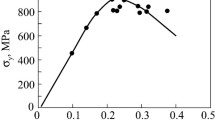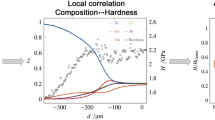What is weakened, reinforces. Softness over comes hardness.
Dao de tszin, XXXVI
Abstract
The phenomenon of softening of crystalline materials by alloying, which is promising for controlling mechanical properties of materials, is due to the occurrence of an additional channel of facilitated formation of dislocation kinks at impurity centers. This effect is related to the kink mechanism of dislocation motion. Hence, a range of materials that are capable of softening can be singled out: metals with a bcc structure, semiconductors, ceramic materials, intermetallic compounds, etc. A unified basis for description of softening regularities is given by the phenomenological theory. This theory predicts many properties that are general for all materials under consideration: the range of strength characteristics of impurities capable of softening crystals, limiting possibilities of softening at the optimal choice of the components, etc. The theory, supplemented with the knowledge of some material constants (determined from microscopic calculations or, even better, from experiment), makes it possible to calculate the temperature and concentration dependences of the yield stress and other parameters measured in mechanical tests.
Similar content being viewed by others
References
E. Pink and R. J. Arsenault, Prog. Mater. Sci. 24, 1 (1979).
L. P. Kubin and F. Louchet, Acta Metall. 27, 337 (1979).
L. P. Kubin, F. Louchet, J. P. Peyrade, et al., Acta Metall. 27, 343 (1979).
Y. T. Chen, D. G. Atteridge, and W. W. Gerberich, Acta Metall. 29, 1171 (1981).
P. Chomel and J. P. Cottu, Acta Metall. 30, 1481 (1982).
G. S. Murty, J. Mater. Sci. 21, 211 (1986).
W. J. Botta, J. W. Christian, and G. Taylor, Philos. Mag. A 57, 703 (1988).
K. Okazaki, J. Mater. Sci. 31, 1087 (1996).
D. Brunner and J. Diehl, Mater. Sci. Eng., A 164(1–2), 350 (1993).
J. R. Patel and A. R. Chaudhuri, Phys. Rev. 143, 601 (1966).
H. Alexander, in Dislocations in Solids, Ed. by F. R. N. Nabarro (North-Holland, Amsterdam, 1986), Vol. 7, Chap. 35, p. 113.
S. Sriram, V. K. Vasudevan, and D. M. Dimiduk, Mater. Sci. Eng., A 192–193, 217 (1997).
H. Inui, K. Ishikawa, and M. Yamaguchi, Intermetallics 9, 119 (2000).
T. E. Mitchell, P. M. Anderson, M. I. Baskes, et al., Philos. Mag. 83, 1329 (2003).
V. P. Soldatov, V. D. Natsik, A. N. Diulin, and G. I. Kirichenko, Fiz. Nizk. Temp. (Kiev) 26, 214 (2000).
T. Kataoka and T. Uematsu, Jpn. J. Appl. Phys. 17, 271 (1978).
J. P. Hirth and J. Lothe, Theory of Dislocations (Wiley, New York, 1982).
E. Nadgorny, Prog. Mater. Sci. 31, 1 (1988).
D. Caillard and J. L. Martin, Thermally Activated Mechanisms in Crystal Plasticity (Pergamon, New York, 2003).
T. Suzuki, S. Takeuchi, and H. Yoshinaga, Dislocation Dynamics and Plasticity (Springer, Berlin, 1991).
Yu. A. Osip’yan, S. I. Bredikhin, V. V. Kveder, N. V. Klassen, V. D. Negriĭ, V. F. Petrenko, I. S. Smirnova, S. A. Shevchenko, S. Z. Shmurak, and É. A. Shteĭman, Électronic Properties of Dislocations in Semiconductors (Éditorial URSS, Moscow, 2000) [in Russian].
N. N. Gorobeĭ, Fiz. Tverd. Tela (Leningrad) 28, 2252 (1986) [Sov. Phys. Solid State 28, 1264 (1986)].
N. I. Medvedeva, Yu. N. Gornostyrev, and A. J. Freeman, Phys. Rev. Lett. 94, 136402 (2005).
O. V. Klyavin, N. P. Likhodedov, and A. N. Orlov, Fiz. Tverd. Tela (Leningrad) 28, 156 (1986) [Sov. Phys. Solid State 28, 84 (1986)].
M. Heggie, R. Jones, and A. Umerskii, Philos. Mag. A 63, 571 (1991).
K. Masuda-Jindo, Phys. Status Solidi B 129, 595 (1985).
M. Wen, S. Fukuyama, and K. Yokogawa, Acta Mater. 51, 1767 (2003).
P. Guyot and J. E. Dorn, Can. J. Phys. 45, 983 (1967).
B. V. Petukhov and V. L. Pokrovskiĭ, Zh. Éksp. Teor. Fiz. 63, 634 (1972) [Sov. Phys. JETP 36, 336 (1972)].
F. Ackerman, H. Mughrabi, and A. Seeger, Acta Metall. 31, 1353 (1983).
T. Suzuki and S. Takeuchi, in Crystal Lattice Defects and Dislocation Dynamics, Ed. by R. Vardanian (Nova Science Publishers, New York, 2000), p. 1.
J. Weertman, J. Appl. Phys. 29, 1685 (1958).
B. V. Petukhov, Fiz. Tverd. Tela (Leningrad) 13, 1445 (1971) [Sov. Phys. Solid State 13, 1204 (1971)].
A. Sato and M. Meshii, Acta Metall. 21, 753 (1973).
B. V. Petukhov, Fiz. Met. Metalloved. 56, 1177 (1983).
V. L. Indenbom and V. M. Chernov, in Elastic Strain Fields and Dislocation Mobility, Ed. by V. L. Indenbom and J. Lothe (Elsevier, Amsterdam, 1992), p. 517.
B. V. Petukhov, M. Bartsch, and U. Messerschmidt, Eur. Phys. J.: Appl. Phys. 9, 89 (2000).
B. V. Petukhov and Yu. I. Polyakov, Kristallografiya 38, 4 (1993) [Crystallogr. Rep. 38, 1 (1993)].
B. V. Petukhov, Fiz. Tverd. Tela (Leningrad) 25, 1822 (1983) [Sov. Phys. Solid State 25, 1048 (1983)].
B. V. Petukhov, Phys. Status Solidi A 90, 225 (1985).
H. Suzuki, in Dislocations in Solids, Ed. by F. R. N. Nabarro (North-Holland, Amsterdam, 1979), Vol. 2, p. 965.
B. V. Petukhov, Fiz. Tverd. Tela (St. Petersburg) 35, 1121 (1993) [Phys. Solid State 35, 571 (1993)].
B. V. Petukhov, Kristallografiya 44(4), 699 (1999) [Crystallogr. Rep. 44, 620 (1999)].
K. Kitajima, Y. Aono, H. Abe, and E. Kuramoto, in Proceedings of the International Conference on the Strength of Metals and Alloys, ICSMA-5 (Pergamon, Amsterdam, 1980), Vol. 2, p. 965.
N. Maeda, K. Kimura, and S. Takeuchi, Izv. Akad. Nauk SSSR, Ser. Fiz. 51, 729 (1987).
C. Levade and G. Vanderschaeve, J. Cryst. Growth 197, 565 (1999).
D. R. Trinkle and C. Woodward, Science 310, 1665 (2005).
D. C. Chrzan, Science 310, 1623 (2005).
Author information
Authors and Affiliations
Additional information
Dedicated to the 50th Anniversary of the Journal
Original Russian Text © B.V. Petukhov, 2007, published in Kristallografiya, 2007, Vol. 52, No. 1, pp. 113–124.




